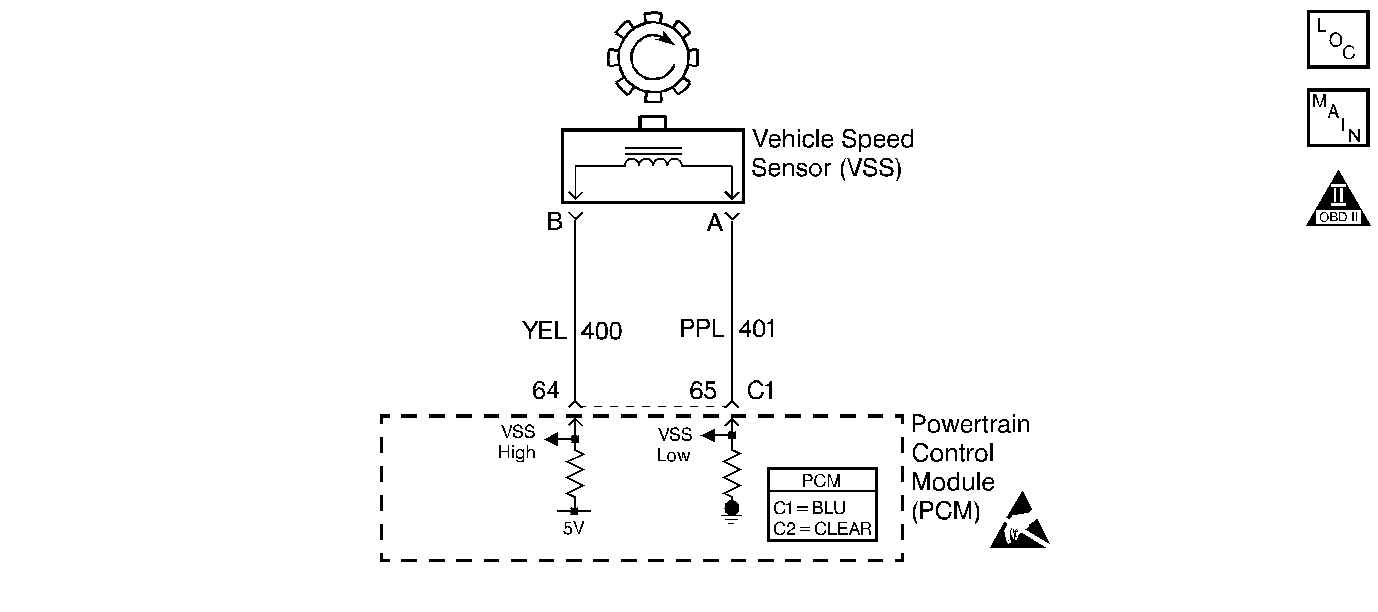
Circuit Description
Vehicle speed information is provided to the PCM by the vehicle speed sensor (VSS). The VSS consists of a magnetic pickup sensor mounted to the transmission case which interfaces with a rotor pressed onto to the transmission output shaft. The VSS produces a frequency signal that is proportional to vehicle speed. The PCM converts the VSS signal to vehicle speed, displayed on the scan tool in miles per hour and kilometers per hour. The PCM also uses the VSS signal to generate the 4000 pulses per mile vehicle speed signal used by the instrument cluster and the TAC module.
Conditions for Running the DTC
| • | Engine speed is more than 1250 RPM. |
| • | Engine load and engine speed acceleration indicate that the vehicle is in gear. |
Conditions for Setting the DTC
Vehicle speed sensor indicates a speed of less than 5 km/h (3 MPH) for more than 20 seconds.
Action Taken When the DTC Sets
| • | The PCM illuminates the malfunction indicator lamp (MIL) on the second consecutive ignition cycle that the diagnostic runs and fails. |
| • | The PCM records the operating conditions at the time the diagnostic fails. The first time the diagnostic fails, the PCM stores this information in the Failure Records. If the diagnostic reports a failure on the second consecutive ignition cycle, the PCM records the operating conditions at the time of the failure. |
| • | The PCM writes the conditions to the Freeze Frame and updates the Failure Records. |
Conditions for Clearing the MIL/DTC
| • | The PCM will turn OFF the malfunction indicator lamp (MIL) during the third consecutive trip in which the diagnostic has run and passed. |
| • | The history DTC will clear after 40 consecutive warm-up cycles have occurred without a malfunction. |
| • | The DTC can be cleared by using a scan tool. |
Diagnostic Aids
Inspect for the following:
Inspect for a Loose or damaged VSS rotor -- A damaged VSS rotor may cause an erratic or incorrect vehicle speed to be displayed. Refer to the Manual Transmission section for on-vehicle service.
Many situations may lead to an intermittent condition. Perform each inspection or test as directed.
Important: : Remove any debris from the connector surfaces before servicing a component. Inspect the connector gaskets when diagnosing or replacing a component. Ensure that the gaskets are installed correctly. The gaskets prevent contaminate intrusion.
| • | Loose terminal connection |
| - | Use a corresponding mating terminal to test for proper tension. Refer to Testing for Intermittent Conditions and Poor Connections , and to Connector Repairs in Wiring Systems for diagnosis and repair. |
| - | Inspect the harness connectors for backed out terminals, improper mating, broken locks, improperly formed or damaged terminals, and faulty terminal to wire connection. Refer to Testing for Intermittent Conditions and Poor Connections , and to Connector Repairs in Wiring Systems for diagnosis and repair. |
| • | Damaged harness--Inspect the wiring harness for damage. If the harness inspection does not reveal a problem, observe the display on the scan tool while moving connectors and wiring harnesses related to the sensor. A change in the scan tool display may indicate the location of the fault. Refer to Wiring Repairs in Wiring Systems for diagnosis and repair. |
| • | Inspect the powertrain control module (PCM) and the engine grounds for clean and secure connections. Refer to Wiring Repairs in Wiring Systems for diagnosis and repair. |
If the condition is determined to be intermittent, reviewing the Snapshot or Freeze Frame/Failure Records may be useful in determining when the DTC or condition was identified.
Test Description
The numbers below refer to the step numbers on the diagnostic table:
Step | Action | Values | Yes | No |
|---|---|---|---|---|
1 | Did you perform the Powertrain On-Board Diagnostic (OBD) System Check? | -- | ||
Does the scan tool indicate vehicle speed more than the specified value? | 0 | Go to Diagnostic Aids | ||
3 | Observe the cluster speedometer with the engine still idling in gear. Does the speedometer indicate vehicle speed more than the specified value? | 0 | ||
4 |
Does the scan tool indicate vehicle speed more than the specified value? | 0 | ||
5 | Test for the following conditions:
Did you find and correct the condition? | -- | ||
6 | Replace the VSS. Refer to Vehicle Speed Sensor in Transmission/Transaxle. Is the action complete? | -- | -- | |
7 |
Important:: The Replacement PCM must be programmed. Replace the PCM. Refer to Powertrain Control Module Replacement/Programming . Did you complete the replacement? | -- | -- | |
8 |
Does the scan tool indicate vehicle speed more than the specified the specified value? | 0 | System OK |
